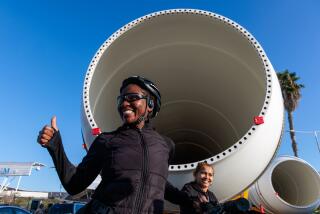Volunteers Restoring Aircraft to Its Former Glory : Aviation: An Antelope Valley College student has organized efforts to refurbish the Douglas Skyrocket. The vehicle is similar to one that first traveled at twice the speed of sound.
- Share via
LANCASTER — The harsh climate of the high desert--extreme heat and cold--can take its toll on most anyone or anything. And after three decades it has taken its toll on one of three Douglas Skyrockets, the first aircraft to travel at twice the speed of sound.
On display at Antelope Valley College, the plane is a sister ship to another Skyrocket that was the first to reach Mach 2--or twice the speed of sound--and is getting a long overdue face lift from a group of volunteers.
Led by an aspiring space station designer, Rick Pedra, members of the informal group of about 15 students and airplane aficionados have devoted much of their spare time since Nov. 2 to restoring the weathered Skyrocket, formally known as a D-558-2.
“It’s pretty corroded,” Pedra said. “The canopy glass has been cracked.”
Mounted on a pedestal, slightly pointed upward as if in flight, the Skyrocket sits in a quad near some classrooms. By the time the volunteers are done, Pedra said the plane will look like it did about 45 years ago when it rolled off the assembly line.
Douglas Aircraft Co., now a division of McDonnell Douglas Corp., built just three of the experimental air-launched Skyrockets as part of a joint aerodynamics research project by the Navy and the National Advisory Committee for Aeronautics (NACA), the predecessor of NASA.
On Nov. 20, 1953, Scott Crossfield flew a Skyrocket at 1,291 m.p.h., slightly faster than twice the speed of sound. Crossfield brought the plane to a landing on a dry lake at Edwards Air Force Base.
All three Skyrockets were retired in 1956. Seven years later, one was put on permanent display at Antelope Valley College, a gift from Douglas, the Navy and NACA.
The Skyrocket that exceeded Mach 2 is on display at the Smithsonian’s National Air and Space Museum in Washington, and the third is part of the collection at Planes of Fame, an air museum run by San Bernardino County at the Chino Airport.
Pedra, who attends Antelope Valley College in preparation for obtaining an aerospace engineering degree, said he kept looking at the plane from the window of his algebra course and thinking how badly it needed refurbishing.
He talked with other aerospace engineering students about it, found there would be plenty of people willing to help restore the plane and then got the nod from college officials who, along with McDonnell Douglas, are donating materials for the work.
An engineering flight test mechanic for McDonnell Douglas, Pedra and the others have hand-sanded the entire Skyrocket, in preparation for a fresh coat of paint.
Finding the exact replacement paint needed for the aircraft, he said, has been difficult. The fuselage will be glossy white, with red, blue, black and yellow highlights. The windshield will be replaced and Pedra hopes to reupholster the pilot’s seat.
It is Pedra’s father, Louis, who will do the detail paint work. Louis came out from Boston to help his son work on the plane. “He has 17 years in aircraft. He’s an old aircraft mechanic from way back.”
Pedra describes the restoration as a labor of love, a project that he was meant to undertake.
“This plane was tested in the early ‘50s,” he said. “The people that tested it, I’m their future. It’s a special breed to be in flight test.”
The Skyrocket also has special meaning to Pedra because it was a NACA plane. Pedra, 27, hopes to some day work for NASA.
“I’m not going to rush it,” he said. “This is real important. When I’m done, it will look immaculate. We’re even repainting the pedestal.”
More to Read
Sign up for The Wild
We’ll help you find the best places to hike, bike and run, as well as the perfect silent spots for meditation and yoga.
You may occasionally receive promotional content from the Los Angeles Times.






